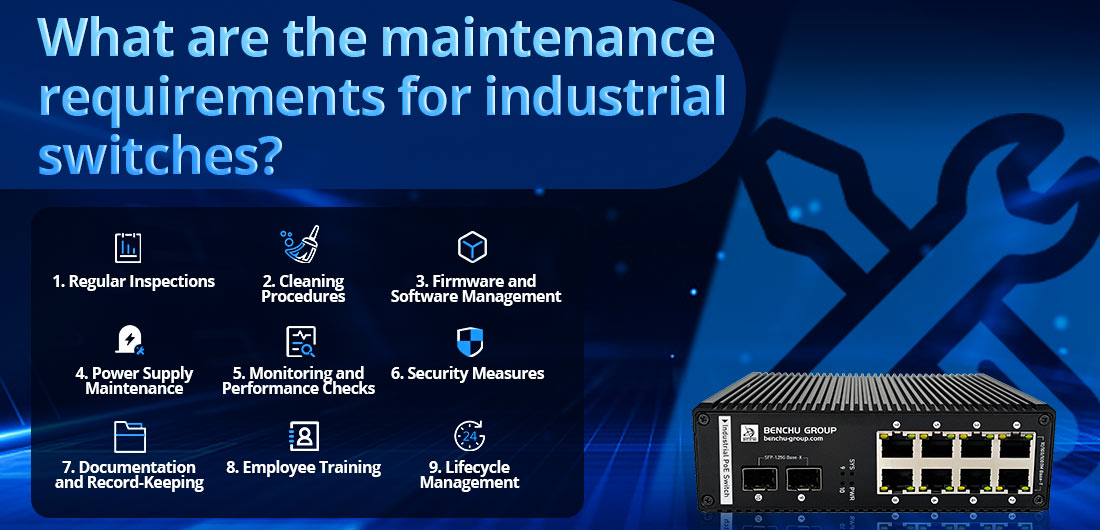
Maintaining industrial switches is essential for ensuring their reliability, performance, and longevity. A structured maintenance approach can prevent issues and minimize downtime. Here’s a detailed description of the maintenance requirements for industrial switches:
1. Regular Inspections
a. Physical Checks
--- Visual Inspection: Conduct routine visual inspections for signs of physical damage, such as cracked enclosures, loose connections, or burnt components. Ensure that all ports are functioning correctly.
--- Cable Management: Check that cables are properly routed and secured, avoiding any strain on connectors.
b. Environmental Conditions
--- Monitor Surroundings: Assess the environment for dust, moisture, and temperature extremes. Ensure that switches are installed in conditions that meet their specifications.
2. Cleaning Procedures
a. Dust and Debris Removal
--- Routine Cleaning: Use compressed air or soft brushes to remove dust from vents, ports, and surfaces. This helps prevent overheating and maintains airflow.
--- Filter Maintenance: If using dust filters or enclosures, clean or replace them regularly to ensure proper ventilation.
b. Moisture Control
--- Check for Leaks: Inspect the area for any signs of moisture ingress, especially in humid environments. Use dehumidifiers if necessary.
3. Firmware and Software Management
a. Regular Updates
--- Firmware Checks: Periodically check for firmware updates from the manufacturer and apply them as needed. Updates often include security patches and performance improvements.
--- Backup Configurations: Before applying updates, back up the current configuration to ensure settings can be restored if needed.
b. Configuration Review
--- Audit Settings: Regularly review switch configurations to ensure they align with network policies and performance requirements.
4. Power Supply Maintenance
a. UPS and Surge Protection
--- Battery Checks: If using an uninterruptible power supply (UPS), regularly test and replace batteries as needed to ensure reliability during power outages.
--- Surge Protection: Verify that surge protectors are functioning correctly and replace them if any signs of damage are present.
5. Monitoring and Performance Checks
a. Network Monitoring Tools
--- Utilize Management Software: Implement network management tools to continuously monitor switch performance, including traffic patterns, latency, and error rates.
--- Alerts and Logs: Set up alerts for unusual activity or performance degradation, and review logs regularly to identify potential issues.
b. Load Balancing
--- Analyze Traffic Load: Regularly analyze traffic patterns to ensure no single switch is overloaded, which can lead to overheating and failure.
6. Security Measures
a. Access Control Reviews
--- Check User Access: Regularly review user access controls and permissions to ensure only authorized personnel can access the switch.
--- Update Passwords: Change default passwords and regularly update security credentials to prevent unauthorized access.
b. Security Patches
--- Apply Security Updates: Stay informed about vulnerabilities and apply security patches promptly to protect against threats.
7. Documentation and Record-Keeping
a. Maintenance Logs
--- Document Maintenance Activities: Keep detailed records of inspections, cleaning, updates, and repairs. This documentation aids in identifying trends and recurring issues.
--- Configuration Backups: Maintain backups of configurations and document any changes made for future reference.
b. Compliance Checks
--- Adhere to Standards: Ensure that maintenance activities comply with industry standards and manufacturer guidelines.
8. Employee Training
a. Staff Education
--- Training Programs: Provide regular training for staff on proper handling, maintenance procedures, and troubleshooting techniques for industrial switches.
--- Emergency Response Training: Train personnel on incident response procedures for handling potential failures or security breaches.
9. Lifecycle Management
a. Evaluate Performance
--- Assess Aging Equipment: Regularly evaluate the performance and reliability of switches. Plan for upgrades or replacements for aging equipment to avoid unexpected failures.
b. End-of-Life Planning
--- Replacement Strategy: Develop a strategy for replacing switches that are reaching the end of their useful life, considering advancements in technology and operational needs.
Conclusion
The maintenance requirements for industrial switches encompass regular inspections, cleaning, firmware management, power supply checks, performance monitoring, security measures, documentation, training, and lifecycle management. By following these practices, organizations can ensure that their industrial switches operate efficiently, remain reliable, and extend their operational lifespan, ultimately reducing downtime and maintenance costs.